The introduced contact with the phlebologist with the developed varicose veins is the main reason that it is too late to respond to the disease with ointment or gel.The doctor should prescribe more effective treatment, among which surgery on varicose veins of the legs is most effective.We should not forget that even the surgical removal of the vessel affected by the disease does not guarantee complete treatment - the disease can spread to healthy tissues.
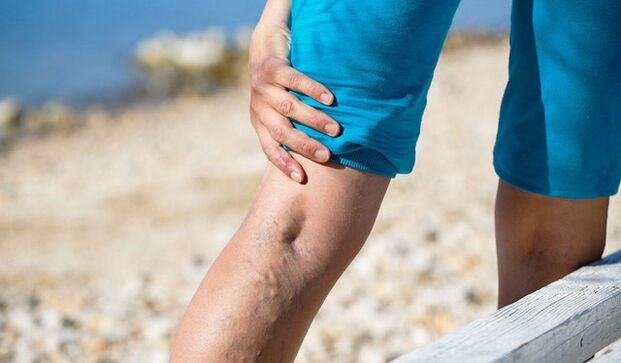
Varicose or varicose veins are a disease characterized by the weakness of the valves in the veins and the dysfunction of the vascular wall, as well as the stagnation of blood in the veins of the lower limbs.This pathology is not only made with a disorder of trophism or nutrition of tissues, a result of which can be a difficult and long -term healing trophic ulcers, but also dangerous in the fact that stagnant blood thickens and blood lines are formed that can be transmitted by blood flow throughout the body.In addition, in the case of thrombotic imposition in the vascular wall (phlebotrombosis), its infection with the development of great diseases is possible - thrombophlebitis.
Varicose surgery
The surgery for varicose veins of the lower limbs is radical and consists in the removal of the subcutaneous veins of the lower limbs (phlebectomy) or in the sclerosis of the deep veins of the lower legs and the hip joint.
Traditionally, phlebectomy (bloodstream) is performed according to the baby method and consists in the introduction of the probe into the lumen of the vein with the subsequent section of the vein completely above its length through the cutting of the skin from the outside.The incision is sewn at the end of the cosmetic seam surgery.
Mini-phlebectomy is used to remove very short areas of the vein, during the operation the veins are not used.Skin cutting is not done and a piece of vein is removed by a thin puncture on the skin that does not require the application of seams.
With a small area of damage to the varicose veins, it is possible to carry out a more tender technique - undress.This extends with a thin hook from just an extended knot.The experience is carried out with two skin cuts with their subsequent suturing.A variety of this technique is cryostropic - "sinking" the vein to the cryoson, using low temperatures, the destructive knot is also stretched.
Vienna sclerosis is the introduction of sclerosant into its lumen - a substance that "sticks" the walls of the vein to each other, but the vein remains deep under the skin and does not perform its functions.The blood flow through the vein stops and passes through collateral vessels without disturbing the leakage of venous blood from the lower limb.Vienna sclerosis is performed under the control of ultrasound.
Laser endovascular coagulation of varicose veins is the most new method in phlebology and consists in the introduction of a thin probe into the lumen of the vein with laser radiation that exerts a cauterizing effect on the walls of the vein.
The radio frequency explanation method also refers to more modern treatment of varicose veins, but not all medical institutions are equipped with appropriate equipment.The technique consists in the effect "cauterizing" on the vascular wall of high frequency radio waves.
Indications for the removal of the veins
Not all patients have been shown surgery, but in some cases it is still impossible to do without it, as it is better to eliminate the source of potential inflammation and blood clots than to expect complications.Countries requiring surgery include the following:
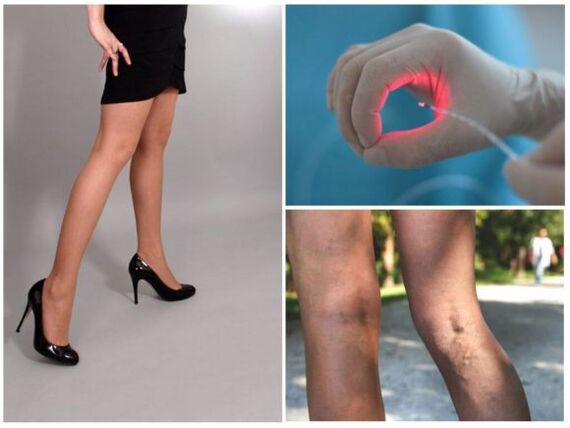
- The risk of occurrence or already occurring thrombophlebitis,
- Frequent exacerbations of thrombophlebitis,
- Huge damage to subcutaneous veins,
- Strong symptoms of varicose veins - a constant feeling of heaviness and pain in the legs,
- Not treating trophic ulcers,
- Eating disorders (trophic) of the tissues of the lower limbs - changes in the color and cooling of the skin of the legs and feet.
Contraindications to surgery
Performing even minimal vascular intervention is contraindicated in the following cases:
- Pregnancy 11 and 111 trimester,
- Acute infectious diseases,
- Exacerbation of chronic diseases (bronchial asthma, diabetes mellitus, stomach ulcer, etc.),
- Acute stroke,
- Acute myocardial infarction,
- Increased inflammation of the lower limbs.
In any case, all indications and contraindications are determined by a phlebologist or surgeon in the course of the patient's full examination.
Which method to choose?
The use of a particular method of treatment is evaluated only by a doctor based on the degree of dissemination of the process.
Of course, with small nodes, less invasive methods are preferable, such as mini-fluctomy, short undressing, laser spread and sclerosis, due to the fact that they are less traumatic and practically do not require a period of rehabilitation.At the same time, with a long length of varicose veins, the preference is given to the traditional phlebectomy, which not only requires spinal anesthesia, but is also a rather traumatic surgery, leaving an aesthetic defect in the form of postoperative scars on the legs.
In this regard, you should not postpone a visit to the doctor at the existing initial stage of varicose veins and, moreover, that you do not need to abandon a less traumatic surgery if the doctor sees the need for it when examined.
When is it better to do the operation?
The decision to need surgical treatment is only taken after consultation with a phlebologist or vascular surgeon.Nevertheless, at an early stage, when the patient is only concerned about aesthetic discomfort in the form of varicose nodes, as well as a slight swelling of the feet at the end of the day, you can try to stop the further progression of the process by using compression knits and venotonics.
In the case where there is pain in the limbs as well as the risk of complications, it is not recommended to slow the surgery.
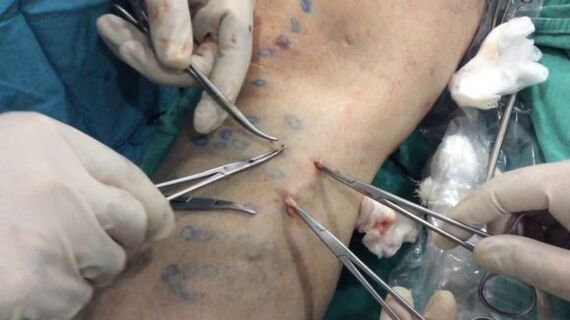
Preparing for surgery
Before planning a vein removal surgery, the patient must perform a number of necessary examinations.These include a consultation with a surgeon or phlebologist, as well as ultrasound of the veins of the lower limbs.In the event that when the patient is shown by the removal of the veins, it is examined at the outpatient stage, more special, general and biochemical blood tests, a blood test for coagulation (INC, Acts, etc.), an ECG and radiography of the breast organs should be performed.
On the day prescribed by a doctor, the patient should come to a medical institution practicing phlebectomy.You can independently shake your hair on the lower legs, thigh and in the area of the inguinal side on the side of the affected limb.You should limit yourself to a light dinner the previous day, you need to come to an empty stomach during the operation.The patient should alert the operating physician and anesthesiologist to the intolerance to the medicines taken earlier.
How the operation is performed
After the patient arrives at the clinic and the initial examination by the surgery and anesthesiologist, the issue of anesthesia is resolved.In the case of conventional phlebectomy, spinal anesthesia is used, with mini-operations, local anesthesia is used by suffocating the skin with novocaine or lidocaine solutions.
After the onset of anesthesia, the surgeon establishes the location of the vein using ultrasound Doppler (UZDG).Then, through a cut on the skin, the probe is introduced and the basic stage of the surgery-cross and dressing of the veins during phlebectomy, stretching the vein with a mini-filectomy (only through punctures) or exposure to the laser on the walls of the vessel is introduced.The main scene takes half an hour to two to three hours, depending on the volume of the operation.
After the main stage, the cut is sewn on the skin, a pressure aseptic dressing is applied to the wound and the patient is accompanied to the ward where it will be monitored for several hours to day.The patient puts a compression linen in the ward, which is not removed for three days.
A day later, the patient goes home.If the surgeon prescribes dressings, the patient visits them every day or every other day.The seams are removed seven days after surgery and two months later, the ups of the lower limbs are performed.
When is the operation not allowed?
Although the surgery to remove veins with varicose veins gives good forecasts and is performed by effective methods, there are still a number of factors, the presence of which is a contraindication to surgery:
Removal of varicose vein phlebectomy
- Deep vein thrombosis of the lower limbs.
- When inflammatory processes appear on the feet, including erysipelas and eczema.
- Heart disease and infectious diseases.
- 2nd and 3rd trimesters of pregnancy.
- Seamless age.
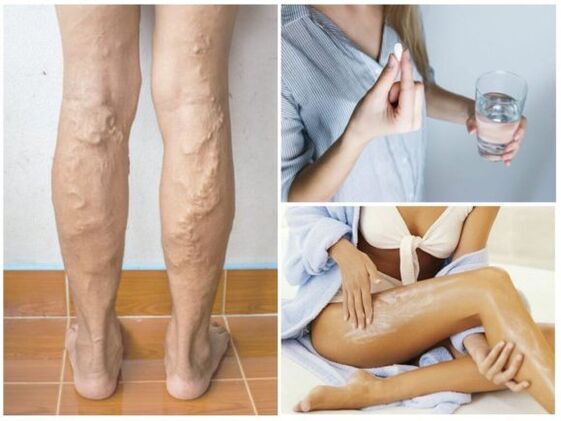
Are complications possible after surgery?
The technique of excellence, aimed at decades, allows you to minimize the risk of postoperative complications.In extremely rare cases (less than 1%), the development of such adverse effects as:
- Post -operative hematomas on the skin - allowed for several months,
- Postoperative seals under the skin on the bed of a remote vein also disappear a month or two after surgery,
- Mechanical damage to the lymphatic vessels leading to lymphostasis (lymph stagnation) is treated conservatively, but after a few months the lymph begins to circulate according to anastomosis and the lymphoto from the limb is performed properly.
- Damage to the subcutaneous nerves manifested by transient skin sensitivity disorders - independently leveled for several months.
Complications and consequences of surgical treatment
No matter how talented the surgeon may be, the varicose veins after surgery are sometimes again felt in the form of complications.No one can guess how this or that organism will behave.After surgery for the removal of varicose veins 2 and 3, there may be consequences that do not require treatment - bruising and hematomas, this is a normal reaction to body damage to tissue.If the patient will follow the recommendations, then everything will go very quickly.Among other consequences, it can be noted:
- abundant bleeding;
- reduction of the sensitivity of the limb (manifests with damage to the subcutaneous nerves);
- Soup when entering infection;
- numbness, etc.
As for pain, they can be observed exclusively with phlebectomy, the other two treatment methods are almost painless.If there are subsequently unpleasant sensations, they easily stop analgesics.
The consequences can be serious;The most dangerous are thromboembolism.It is a sharp obstruction of a blood vessel with a thrombus that broke away from the site of its location and circulates with the bloodstream.If the patient is assisted in a timely manner, then he or she can become a disabled person and even die.
Forecast and lifestyle after surgery
After surgery, pain in the operated limb and minor edema are possible for several days.To stop the unpleasant symptoms, the doctor is prescribed non -steroidal drugs - ketorol, string, etc.Immediately after surgery, the patient should start wearing compression linen and perform physiotherapy exercises prescribed by the doctor.
On the second day after surgery, the patient is allowed to walk a little.After a week or two, slow walking should be guaranteed for several hours a day.
Such provisions such as ::
- Rejection of bad habits,
- Proper nutrition except fat and harmful products,
- Compliance with the mode of work and rest,
- Exclusion in working hours only on a stuck or only standing position - a change in the position of the limbs in the process is necessary.
In conclusion, I would like to point out that if I judge the reviews, vein removal operations are favorable enough and there are practically no serious complications.In addition, the risk of life -attracting complications of varicose veins (thromboembolism, for example), sharply decreases after the removal of the varicose vein.Currently, the limb amputation due to severe inflammation and even gangrene due to thrombophlebitis (especially against the background of diabetes) is not uncommon, so it is better to contact the surgeon at an early stage and not refuse to remove the veins if needed.In this way, you will stay not only for healthy limbs, but also the health of the whole body as a whole.
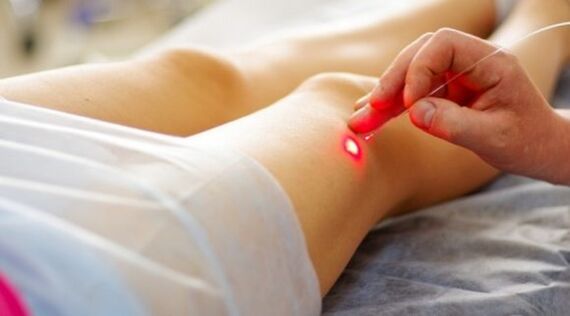
Preventive measures
With adverse heredity, when relatives diagnosed varicose veins or person are at risk for other reasons, it is important to take prevention measures:
Varicose injection
- Regularly take Vitamin C, which strengthens the walls of blood vessels and improves the characteristics of the blood composition;
- Use medicines, their administration should be agreed with a doctor;
- Use compression linen;
- Physical upbringing is important, swimming, walking, cycling, blood riding well.
Prevention also implies a transition to a healthy lifestyle - you need to review the diet and give up bad habits.


















